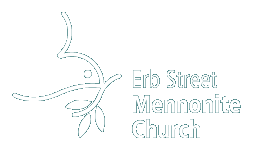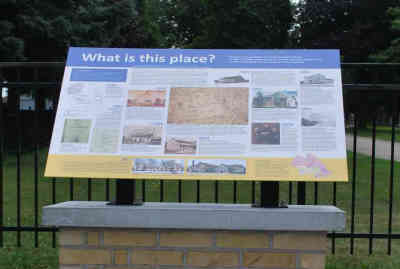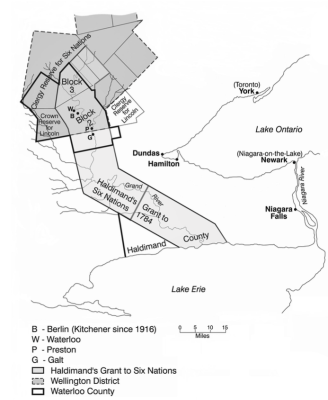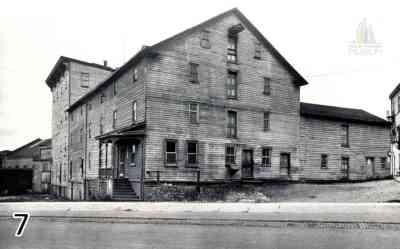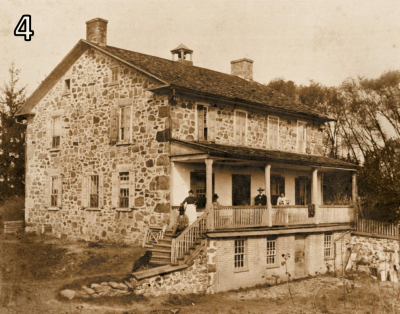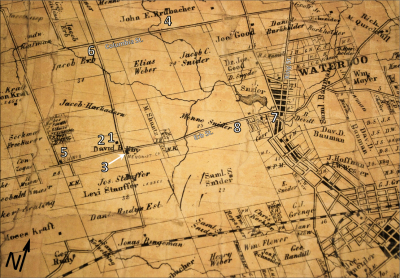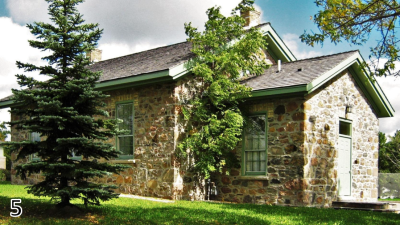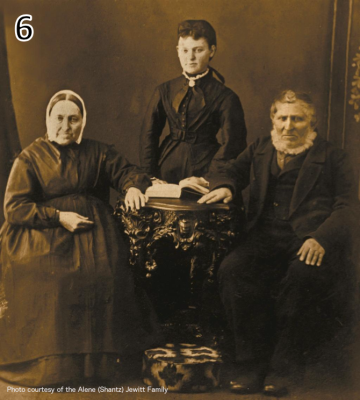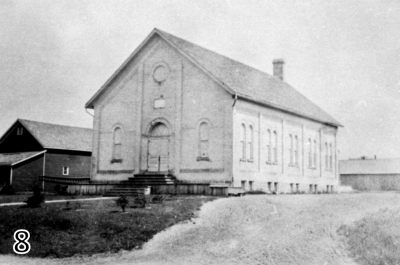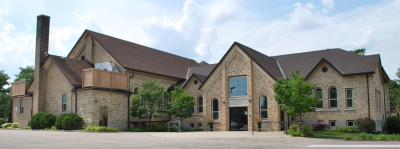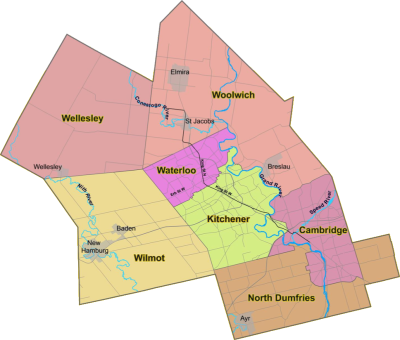History Panel – What is this place?
There is a History Panel mounted at our cemetery. It is wonderfully and thoughtfully laid out. And totally impractical to re-post here in its original form. We would hope you get a chance to visit the cemetery and see the panel in all its glory, but if you can’t, or can’t wait, the below is a reinterpretation of the layout so you can appreciate the information. Numbers on the images refer to locations on the Tremaine Map. Clicking here will open a copy in a new window you can use as reference. Click on any image to see it in more detail and use your browser’s back button to return. We thank the photo providers (listed below with their photos) for allowing us to use them here and on the panel.
What is this place?
This panel was created by Erb Street Mennonite Church to mark the 180th anniversary of our earliest recorded worship service in 1837, at the David Eby farm, located at this crossroads.
The Erb Street Mennonite congregation has had a presence on Erb Street since the early 1800s. Where you are now standing, they established a cemetery and built a meetinghouse in the 1850s (see 3, below).
A few decades before that, the first non-Indigenous settlers here, David and Elizabeth (Bechtel) Eby, cleared land for a farm. But their story begins even earlier…
In the late 1700s, Mennonites and others from Pennsylvania had established farming settlements in the Niagara region of Upper Canada. Soon after, the northern half of the Haldimand Tract that encompassed the Grand River was divided into a few large “blocks,” which were further divided into lots and offered for sale. A group of Pennsylvania Mennonites, often referred to as the German Company, bought much of 60,000-acre Block Two. The Erb Street Mennonite Church Cemetery is part of Block Two, Lot 32, settled by David and Elizabeth Eby, likely by the 1820s.
In the early 1800s, the small, dispersed Mennonite community in Block Two rotated its schedule of Sunday worship services among several locations, many of them on farms. These were known by the landowners’ names. One of them – “David Eby’s” – was the Eby farm. Around 1850 the Ebys provided this small portion of their land for a brick meetinghouse for Sunday services, as well as a cemetery. In 1902 a new church was built, now at 131 Erb St. W. In 2017 Erb Street Mennonite Church, descendant of the David Eby congregation, celebrated the 180th anniversary of its earliest recorded service. On this panel is some of the story of the congregation, and this neighbourhood, in their early years.
Land Acknowledgement
We acknowledge that Erb Street Mennonite Church meets on the traditional territory of the Neutral, Anishnaabeg, and Haudenosaunee peoples who continue to have an unresolved interest in the lands within six miles of the Grand River. This area is known as the Haldimand Tract, land promised to the Six Nations that includes our church building at 131 Erb Street West, our cemetery at 407 Erb Street West, and land we lease to Shalom Counselling at 9 Avondale Avenue South. We continue to work and pray for justice and reconciliation.
1784 Haldimand Tract
Image Source: Adapted from The Amish and Their Neighbours by Lorraine Roth. Courtesy of Pam Schaus, Wilfrid Laurier University; Mennonite Historical Society of Ontario and St. Jacobs Printery
1816 Erb’s / Snider’s Mill c.1927
Image Source: City of Waterloo Museum
An increase in farmed land after 1810 meant an increase in the local grain harvest. To process it, Abraham Erb, who had built a sawmill a few years earlier, added a grist mill in 1816 near today’s southwest corner of King and Erb Streets. They were among the first permanent structures in Waterloo. Three years later construction was approved for a road, which came to be known as Erb’s Road or Erb Street, connecting Erb’s mill with the new farms to the west, including the Ebys’ farm. In 1829 the mill was sold to Jacob Snider and it remained in that family until 1926. Several generations of Sniders attended David Eby meetinghouse and then Waterloo / Erb Street Mennonite Church.
1837 Church Calendar for Waterloo Area Mennonites
Image Source: Mennonite Archives of Ontario, Waterloo
Translation of Cover:
A Calendar, or Register of the meetings of the Mennonites to be held in Halton County, Upper Canada; for the year of our Lord 1837. Second Issue: Berlin, Upper Canada, Printed by Henry Eby.
1842 David & Elizabeth (Bechtel) Eby Farm
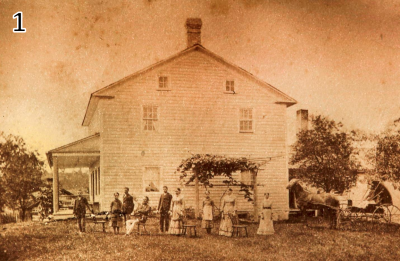 Image Source: Margaret Rowell, Waterloo
Image Source: Margaret Rowell, Waterloo
In 1842, the Ebys built a two-storey log house on the hill slightly west of where the commercial plaza is located today, diagonally across the intersection from where you are standing. In this undated photo (c.1900), the logs are covered by siding. Later occupants of the house included, successively, the family of David B. Eby (son of David and Elizabeth) and his wife Lydia (Bowman), as well as a Snyder family and a Hallman family. It is believed the Snyders or Hallmans are shown here.
1850 John & Magdalena Brubacher Home
Image Source: Mennonite Archives of Ontario, Waterloo
In 1850, John E. and Magdalena (Musselman) Brubacher built a house of fieldstones gathered from their land: Lot 25 of the German Company Tract, bought by John’s grandmother, Susannah (Erb) Brubacher. The Brubachers lived close enough to both David Eby meetinghouse, and Martin meetinghouse (at King and Bridge Streets), that they could travel to either location for services, depending on the worship schedule. Now a museum, the house (on Frank Tompa Drive) is owned by the University of Waterloo and managed by the Mennonite Historical Society of Ontario and Conrad Grebel University College. Martin meetinghouse and cemetery are still in use.
1851 A Mennonite Meetinghouse (not David Eby meetinghouse)
Image Source: Mennonite Archives of Ontario, Waterloo
No photo of the red brick David Eby meetinghouse is known to exist, but the one at left is thought to be of similar design. Completed by 1851, David Eby meetinghouse was possibly located between today’s cemetery laneways, where brick has been unearthed. With the completion of the meetinghouse, Sunday services no longer took place in the Ebys’ farm buildings. The meetinghouse was used until 1902, when the congregation built a new church (today’s Erb Street Mennonite Church) near town. The last known use of the meetinghouse, late in 1902, was as an encampment site for Indigenous workers in the local sugar beet harvest. Neighbourhood lore has it that bricks from the demolished meetinghouse were used to build a house, which still stands, behind the 1902 church property.
1861 Tremaine Map of Waterloo Township
Image Source: Grace Schmidt Room, Kitchener Public Library
This section of the 1861 Tremaine Map shows, at left centre, the second-generation farm of David B. and Lydia (Bowman) Eby as well as the “Menonist Ch” [sic] – David Eby meetinghouse – at what is today the Fischer-Hallman Road and Erb Street West intersection. The compact village of Waterloo is at right centre. At its western edge is a millpond for waterpower, today the site of Silver Lake in Waterloo Park. The map shows landowners who were part of the David Eby Mennonite community, including Jacob C. and Elizabeth (Cressman) Snider, Samuel S. and Anna (Snider) Snider, Menno and Sarah Ann (Bricker) Snider, John E. and Magdalena (Musselman) Brubacher, Jacob B. and Mary (Clemens) Erb, Joseph and Rebecca (Rosenberger) Stauffer, Jacob and Mary (Miller) Heckendorn, Jonas and Elizabeth (Brubacher) Bingeman, and George and Barbara (Lichty) Rudy.
1867 Rummelhardt School
Image Source: ©Mac Armstrong/Wikimedia Commons/CC BY-SA 3.0
Marked on the map as “S.H. No.9,” Rummelhardt School was built on Erb’s Road about 1 km west of the Eby farmstead, on 1.5 acres bought from David Eby Sr. The original 1844 log schoolhouse was replaced with a stone building in 1867. It is one of the few remaining stone school buildings in Waterloo Region, and was restored by its current owner, Kitchener- Waterloo Bilingual School, in partnership with the City of Waterloo and the Waterloo Regional Heritage Foundation.
1870s Erb Family
Image Source: The Alene (Shantz) Jewitt Family
Mary (Clemens) Erb, Jacob B. Erb, and their daughter Mary Ann (Erb) Mosser, were descendants of Mennonite settler families who arrived in the Waterloo area between 1805 and 1810. This photo, taken before 1879, is among the earliest known to exist of the Mennonites in this neighbourhood.
Jacob and Mary Erb attended David Eby meetinghouse, and their farm was located a bit north of the Eby farm, where today’s Columbia Street and Fischer-Hallman Road cross. Members of the Erb family are sure to have attended Rummelhardt School, and some of their descendants still attend Erb Street Mennonite Church.
1895 Hallman Barn (on former Eby farm)
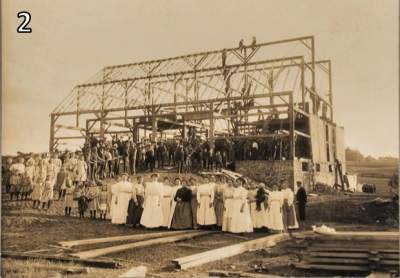 Image Source: Waterloo Region Museum, Kitchener
Image Source: Waterloo Region Museum, Kitchener
Gathering for a barn raising on the Irvin C. and Elsie (Stauffer) Hallman farm, c.1895. The builder was Gregor Schnarr, a farmer and a carpenter who lived nearby, in Erbsville.
1902 Waterloo Mennonite Church (renamed Erb Street Mennonite Church in 1940s)
Image Source: Waterloo Historical Society
By 1900, the old practice of sharing from a pool of preachers had changed, and the David Eby congregation had its own pastor, Noah Hunsberger. In 1902 the congregation moved from its meetinghouse to a new church, built at the developing edge of Waterloo on land provided by members Samuel S. and Elizabeth (Reist) Snider. As well as a name change to “Waterloo Mennonite Church,” the new building brought other changes, including: a basement; a furnace; decorated pews instead of plain meetinghouse benches; electric lighting powered by a link to the generator at William Snider’s grist mill on King Street. Shown in this early photo is the 1902 building, which survives today as the oldest section of Erb Street Mennonite Church, still visible among later additions and renovations.
2017 Erb Street Mennonite Church
The story of this place, where you are standing, continues a few blocks east, at Erb Street Mennonite Church. Our members and congregants come not only from the neighbourhood, but from all of Waterloo Region and beyond, and from many different backgrounds. Part of Mennonite Church Eastern Canada, we are a welcoming and inclusive community of diverse persons, each contributing uniquely to our common purpose of following Jesus Christ. Through service and in sharing God’s word with our neighbours across the street and around the world, we reflect and testify to the good news of God’s love, so that we may all know God’s justice and healing. From our Vision Statement
Waterloo Region
Image Source: Elizabeth Siddorn, Information Technology Services, Region of Waterloo
Originally promised to the Indigenous peoples of the Six Nations, the northern half of the Haldimand Tract was eventually divided into numbered blocks, with Block Two named Waterloo Township in 1816. Waterloo Township became part of Waterloo County when the county was established in 1853. Today, the original Block Two is within the Regional Municipality of Waterloo (since 1973). The former footprint of Block Two is now occupied by Kitchener, Waterloo, part of Cambridge, and part of Woolwich Township.
